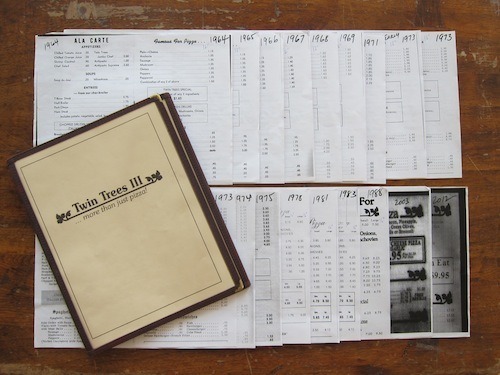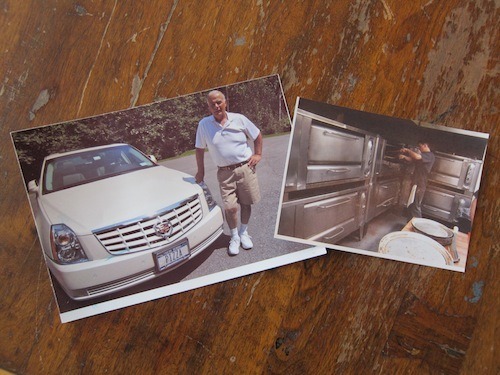
Twenty menus spanning half a century from a pizzeria in N. Syracuse, NY.
I’m not a big fan of menus. Lists of options often leave me fixated on all the food I didn’t order so I usually stick with friends’ recommendations or staff picks without even looking at the page. But as much as I dislike using them, menus are incredible tools. They provide an extremely interesting historical record of what was important to a restaurant at a single point in time. In the midst of a recent move, I found a package sent to me by the owner of a pizzeria in North Syracuse, NY called Twin Trees III.
The package contains some pizzeria goodies: a pizza box, a t-shirt, a photo of owner Louis Rescignano showing off his PIZZA vanity license plate and a stack of menus. But this isn’t a stack of menus in the “Hand these out to your friends so they can buy my pizza” sort of way. It’s a stack of twenty menus spanning the past 50+ years. So with an empty new apartment and a Superstorm keeping me inside, I set about reading the story told by this Rosetta Stone of pizzeria menus collections.

Notice the spelling of “muzzarella” in this 1964 menu.
The original Twin Trees opened in 1957 but the oldest menu I have is from 1964. Besides pizza there are steaks, chops, pasta, seafood and salad. At this time, pizza was still soaking into the American consciousness and remained a sidebar in Italian restaurant menus. A note on the page indicates that the pizzas are all 12 inches in diameter. A “Plain-Cheese” pizza is just $1.15 and every topping is just twenty cents more. The most expensive pie is the “Twin Trees Deluxe,” ringing in at a whopping $2.00 for sausage, mushrooms, onions, peppers and anchovies. Pepperoni is an option, but a letter from the owner tells me it wasn’t on the menu when he started making pizzas in 1962. America’s favorite topping was a latecomer to the pizza party, but we’ll see it rise to power in just a few years.
By 1971 the price of a 12-inch pizza is $1.70. Pizza’s still on the right side of the menu, a powerful position since the eye naturally goes in that direction. All the same toppings are there, but as of the 1968 menu anchovies had lost their status as the first listed topping with a drop down to third position. Interestingly enough, a new option appears on this menu: add pepperoni or anchovy to any of the seven listed pizza options for a total of $2.25. Shifting ahead to the contemporary pizza climate, pepperoni is the most popular topping in the US while anchovy is the least (although it’s still listed on the side of most pizza boxes as an option). Nevertheless, as of 1971 these two toppings were on equal ground in North Syracuse, NY.

Check out the font change in 1973. Classy!
No big changes until the introduction of two different sizes in 1978. Small pizzas are 12 inches and large pies are 16. There’s a major price leap from seven years earlier, with small cheese pies fetching $3.15 and a large $4.65. You can see the leap in profitability with the larger size. This menu also has an organizational shift with a simple list of topping options. Pricing now depends on the number of toppings ordered and anchovy somehow manage to claim an entire line without having to share space with pepperoni. We lost my beloved “muzzarella” back in 1975 in favor of the much simpler “cheese.” It’s safe to say mozzarella was the assumed cheese by this point so it was unnecessary to get any more detailed. Anchovy eventually gets squeezed out in 1978 and pepperoni’s back in with its own line (yet it’s not listed in the general topping section).

Gotta love the pizzeria owner showing off his PIZZA license plate. He also sent me a photo of his army of Blodgett ovens.
Sadly, there are no menus from the 1990s in this collection so we can’t pick back up until 2003. By this point it’s a pretty common pizza menu. The fifteen year span added bacon, ham, black olives, roasted peppers, meatball, sliced tomato, hot peppers, green olives, broccoli and pineapple to the previously limited list of topping options. Times have most certainly changed, as evidenced by the addition of a $3.50 salad bar and a pizza buffet for $9.95 every Thursday. I hate to draw the comparison but I remember Pizza Hut having similar options.
This menu collection is a real window into the evolution of a restaurant over half a century. Regardless of year, Twin Trees has always been very clear to its customers that it is “Famous for Pizza.”
This piece originally appeared on Slice: America’s Favorite Pizza Weblog.

